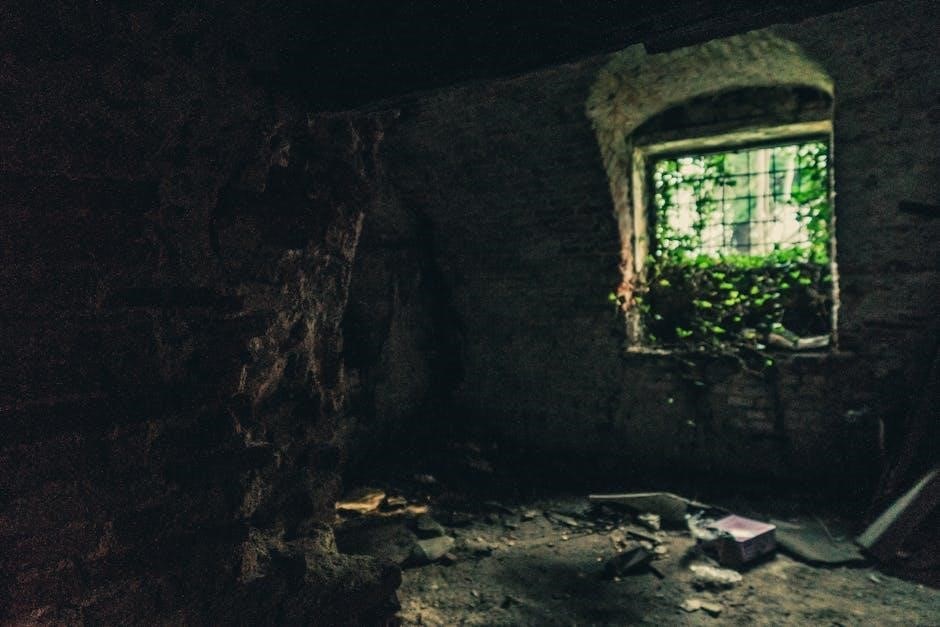Welcome to the Vintage Story Guide, your comprehensive resource for mastering survival, crafting, and exploration in this challenging yet rewarding game․ Learn essential strategies, key milestones, and expert tips to thrive in its intricate world․
1․1 Overview of Vintage Story
Vintage Story is a survival sandbox game that challenges players to thrive in a harsh, procedurally generated world․ With its unique blend of exploration, crafting, and strategy, the game offers a deep and immersive experience․ Players must manage resources, craft essential tools, and build shelter while navigating the dangers of the environment․ The game features multiple world presets, each offering distinct challenges, from the forgiving Standard mode to the unforgiving Wilderness Survival․ Key mechanics include temporal stability, which affects gameplay progression, and a robust crafting system that evolves as players advance through ages․ The game emphasizes preparation, with milestones like shelter, winter survival, and the Copper Age guiding players through their journey․ Mastery of these elements is crucial for long-term success in Vintage Story․
1․2 Importance of a Guide for Survival
A guide is essential for survival in Vintage Story due to its complex mechanics and unforgiving environment․ The game demands careful resource management, strategic planning, and a deep understanding of its systems․ Without guidance, players may struggle with temporal stability, crafting efficiency, and preparing for challenges like winter․ A guide provides clarity on prioritizing tasks, such as securing shelter, managing hunger, and advancing through technological ages․ It also highlights critical milestones and offers tips to avoid common pitfalls, ensuring a smoother and more enjoyable experience․ By following a guide, players can optimize their progress, reduce frustration, and fully immerse themselves in the game’s rewarding survival experience․
1․3 Key Features of the Game
Vintage Story offers a rich survival experience with a focus on crafting, exploration, and strategy․ Key features include a dynamic open-world environment, multiple game modes like Standard and Wilderness Survival, and a complex crafting system․ Players must manage resources carefully, as items degrade over time, and crafting requires precise recipes․ The game emphasizes temporal stability, which affects gameplay mechanics and base setup․ Milestones like preparing for winter and achieving the Copper Age add depth, requiring players to plan ahead․ With its challenging mechanics and immersive world, Vintage Story rewards patience, creativity, and adaptability, making it a standout title in the survival genre․

World Creation and Settings
Vintage Story offers customizable world presets like Standard, Wilderness Survival, and Exploration․ Adjust settings such as tree growth rate and Polar-Equator distance for a tailored experience․ Temporal stability is crucial for base setup, ensuring minimal distortions and damage over time․ Proper worldgen configurations and early customization choices significantly impact gameplay, making pre-world planning essential for success․
2․1 Understanding World Presets
In Vintage Story, world presets define the game’s difficulty and mechanics․ Standard is recommended for newcomers, offering a balanced survival experience․ Wilderness Survival is extreme, with harsh death penalties and disabled maps․ Exploration mode focuses on discovery, while Homo Sapiens mode adds unique challenges․ Each preset alters resource availability, enemy behavior, and environmental hazards․ Understanding these presets helps tailor your playstyle and expectations․ For example, Wilderness Survival demands meticulous planning due to its unforgiving nature․ Adjusting settings like tree growth rate and Polar-Equator distance can further customize your experience․ Temporal stability is crucial in all modes, affecting base setup and survival․ Immersive Mouse Mode enhances interaction, while marking key locations ensures resource management․ Choose your preset wisely to align with your skill level and goals․
2․2 Customizing World Settings
Customizing world settings in Vintage Story allows for a tailored experience․ Adjusting tree growth rates to 1x or 0․25x reduces time spent gathering firewood․ Modifying the Polar-Equator distance ensures easier access to equatorial resources․ Immersive Mouse Mode enhances interaction by keeping menus in-world, aiding storage management․ Temporal stability is vital; moving to stable areas prevents decay and HP damage․ Beds don’t set spawn points; Temporal Gears are needed for respawning․ Early resource focus on flint, sticks, and cattails aids tool crafting․ Marking map locations prevents losing valuable resources․ Using bones for tools conserves sticks and boosts durability․ Prioritizing shelter with packed dirt avoids cave-ins․ Managing hunger with berries and hunting, though time-consuming, sustains early survival․ These adjustments and strategies ensure a smoother start and better preparation for the game’s challenges․
2․3 Importance of Temporal Stability
Temporal stability is crucial for a stable base setup, even temporary ones․ If the gear above ground spins counter-clockwise, it signals decay, leading to distortions and HP damage over time․ Beds do not set spawn points; instead, rare Temporal Gears are required to reset spawn locations, with limited uses depending on world settings․ Ensuring temporal stability prevents these issues, safeguarding your progress and health․ Regularly monitoring and relocating to stable areas is essential for long-term survival and avoiding unnecessary challenges early in the game․

Early Survival Strategies
Focus on gathering flint, sticks, and cattails for basic tools and shelter․ Prioritize resource management and mark important locations on the map to ensure early survival success․
3․1 First-Day Focus and Priorities
Your first day in Vintage Story is crucial for setting up a strong foundation․ Gather flint or knappable stones and sticks to craft essential tools like knives and axes․ Cattails or papyrus are vital for creating handbaskets and reed baskets, which improve inventory management․ Shelter construction should be a top priority to protect yourself from nighttime dangers․ Consider building a simple dirt hut or log cabin using nearby materials․ Resource management is key; focus on collecting firewood and crafting a firestarter to light campfires and torches․ Avoid wasting time on non-essential activities like hunting, as it offers poor returns early on․ Mark important locations on your map, such as resource-rich areas or potential shelter sites, to ensure you can return to them later․ Efficiency and focus will help you survive the challenging first day․
3․2 Shelter Construction Basics
Building shelter is one of your first priorities in Vintage Story․ Start with simple structures like a dirt hut or log cabin using readily available materials․ Logs and thatch are excellent choices for durability and ease of construction․ Avoid using normal soil or gravel, as they risk cave-ins; opt for packed dirt instead․ Torches are essential for lighting, but be cautious of fire spreading․ A basic shelter protects you from nighttime threats and provides a safe space to store items․ Keep your early shelter simple and functional, as you can expand or upgrade it later․ Prioritize building near resources like water and trees for convenience․ A well-built shelter is your first line of defense in this unforgiving world․
3․3 Resource Management Tips
Effective resource management is crucial for survival in Vintage Story․ Prioritize gathering flint and sticks for crafting essential tools like knives and axes․ Use cattails or papyrus to create baskets for better inventory management․ Focus on collecting firewood and charcoal early, as they are vital for cooking and crafting․ Avoid wasting resources on non-essential items until you have a stable base․ Bones can replace sticks for tool crafting, saving valuable materials․ Mark important resource locations on your map to avoid losing track․ Manage your hunger by cooking meals, which provide higher satiety and reduce spoilage․ Efficient resource gathering and storage will help you progress smoothly through the game and prepare for challenges like winter․

Key Milestones in the Game
Mastering Vintage Story involves overcoming critical milestones like securing shelter, surviving winter, achieving the Copper Age, and implementing automation․ Each milestone builds on the last, ensuring progress and sustainability in the game’s challenging world․
4․1 Shelter and Safety
Securing shelter is your first priority in Vintage Story․ A well-constructed shelter protects you from harsh weather, predators, and hazards․ Start with simple structures like a dirt hut or log cabin, using materials like packed dirt or wood․ Ensure your shelter is sturdy to prevent collapses, especially in caves․ Safety is crucial, so keep a fire starter and torches nearby․ As you progress, upgrade your shelter with better materials and consider adding a bed for a spawn point․ Temporal stability is key; avoid areas with decaying stability to prevent damage․ Marking resources on your map helps you remember valuable locations for future use․
4․2 Preparing for Winter
Preparing for winter is crucial in Vintage Story․ Ensure you have a sturdy shelter with a reliable heat source, as cold temperatures can be deadly․ Stockpile food by farming crops and preserving them in storage urns or crocks․ Furs are essential for warmth, obtained by hunting animals like sheep, pigs, or wolves․ Manage your resources wisely, as winter limits resource gathering․ Consider crop rotations and protect your farm from pests․ Store extra clothing to avoid wear and tear․ Mark resource locations on your map to avoid losing them․ Without proper preparation, winter can be devastating, so prioritize these steps to survive the harsh season․
4․3 Achieving the Copper Age
Achieving the Copper Age is a pivotal milestone in Vintage Story․ To progress, gather 40 copper nuggets, craft a clay crucible, and create molds for a hammer and pickaxe․ Prioritize finding surface copper deposits and mark their locations on your map for future mining․ Use a shovel to excavate underground ore, ensuring you relieve rock blocks for efficient extraction․ Panning in rivers can also yield copper bits, though it’s time-consuming․ Once equipped with copper tools, you’ll unlock advanced crafting options, enabling better resource gathering and progression․ This milestone is essential for transitioning to more durable tools and laying the groundwork for future technological advancements in the game․
4․4 Automation and Efficiency
Automation and efficiency are crucial for long-term success in Vintage Story․ Start by gathering resources like fat, resin, and flax to craft essential items; Windmills and querns are key for automating tasks such as grinding grain or pumping water, saving time and effort․ Use crop rotation to maximize farm output and protect your crops from pests․ Consider domesticating animals for sustainable resources like feathers and dairy․ Automating repetitive tasks allows you to focus on exploration and crafting, significantly improving your quality of life in the game․ By streamlining your workflow, you can achieve greater efficiency and progress further in your survival journey․

Tools and Weapons Crafting
Craft essential tools like knives, axes, and shovels using flint and sticks․ Bones can replace sticks for added durability․ Progress to copper tools for efficiency, unlocking advanced crafting options and better resource management․ Prioritize crafting weapons like spears for early defense․ Manage resources wisely to maintain tool quality and longevity, ensuring survival in the game’s challenging environment․
5․1 Basic Tools for Survival
Crafting basic tools is crucial for survival in Vintage Story․ Start with a knife, axe, and shovel using flint or knappable stones and sticks․ Bones can replace sticks, offering extra durability․
These tools enable resource gathering and early-game progress․ Prioritize flint and sticks, as they are essential for crafting․ Use bones to conserve valuable resources․
Mark resource locations on your map to avoid losing them․ Early tools may not be durable, but they provide the foundation for more advanced crafting․ Manage your inventory wisely to ensure tool availability․
These basic tools are your lifeline in the early stages, so craft and maintain them carefully to survive and thrive․
5․2 Progression in the Copper Age
Reaching the Copper Age is a pivotal milestone, enabling advanced tool crafting․ Begin by crafting a pickaxe, hammer, and anvil, which are essential for mining and smithing․
A saw is also crucial for creating crates and barrels, improving storage and efficiency․ To progress, gather 40 copper nuggets, craft molds, and use a crucible for smelting․
Tongs are necessary for handling hot items, and quenching metals in water improves durability․
Charcoal production is vital, so establish a reliable source early․
Mark copper locations on your map to revisit and mine underground deposits․
This era lays the groundwork for future advancements, so prioritize efficient resource management and tool crafting․
5․3 Advanced Crafting Techniques
Mastering advanced crafting techniques unlocks sophisticated tools and items, enhancing efficiency and survival․
Once you have a saw, craft a chisel to create intricate designs and unlock the fruit press for processing resources․
Leather production becomes crucial for armor and backpacks, though it requires patience due to its lengthy crafting time․
The quern is a game-changer, enabling flour production for bread and mortar for construction․
Automation begins with simple mechanisms like windmills, reducing manual labor and streamlining resource gathering․
Advanced crafting also involves optimizing charcoal production and metalworking, ensuring durability and versatility in your tools․
Experiment with complex recipes and specialized items to refine your gameplay and prepare for long-term challenges․

Food and Nutrition
Proper food management is vital for survival, boosting health and energy․ Cooking meals doubles satiety, reduces spoilage, and provides sustained nourishment, essential for long-term success in the game․
6․1 Importance of Cooking
Cooking is a cornerstone of survival in Vintage Story, significantly enhancing food efficiency․ Cooked meals provide double the satiety of raw ingredients, reducing hunger and extending the duration of nourishment․ This allows for better resource management and more time for exploration and crafting․ Additionally, cooking prevents food spoilage, ensuring that your hard-earned resources last longer․ Meals also offer a unique benefit by pausing hunger depletion for a short period, giving players a much-needed break․ To start cooking, craft a cooking pot and bowl, which are essential for preparing meals․ Prioritizing these tools early ensures a steady food supply, crucial for overcoming the game’s challenges․
6․2 Managing Hunger and Health
Managing hunger and health is critical for survival in Vintage Story․ Hunger directly impacts health and stamina, so keeping your food bar replenished is essential․ Injuries worsen hunger, creating a dangerous cycle․ Always prioritize healing by maintaining high satiation, especially when injured․ Avoid risky actions that cause unnecessary harm, as injuries escalate hunger depletion․ Use cooked meals for sustained nourishment and prevent spoilage with proper storage․ Monitor your health closely, as low satiation hinders healing and increases vulnerability․ Balancing hunger and health ensures longevity and effectiveness in the game world, allowing you to focus on exploration and progression without constant setbacks․
6․3 Farming and Crop Management
Farming is a cornerstone of long-term survival in Vintage Story, providing a steady food supply and resources․ Start crops early in medium fertility soil for optimal growth․ Protect your crops from rabbits by creating barriers or using traps․ Crop rotation and tilling wild crops can boost yield and deter pests․ Use a hoe to till soil and plant seeds, ensuring proper spacing for growth․ Regularly harvest and store crops in sealed containers to prevent spoilage․ Consider dedicating areas for flax and other essential crops․ Farming not only sustains you but also supports advancements like animal domestication and automation, making it a vital skill for thriving in the game․

Combat and Defense
Mastering combat and defense is crucial for survival․ Understand threats, craft weapons like spears, and set up traps․ Build secure shelters and use torches strategically to deter enemies․
7․1 Understanding Threats
In Vintage Story, threats range from wildlife to environmental hazards․ Wolves, bears, and hostile mobs pose constant dangers, especially at night․ Environmental factors like harsh weather and temporal instability can also harm you․ Understanding these threats is key to survival․ Wildlife behaves realistically, with predators attracted to noise and weak defenses․ Bears are particularly dangerous, so avoid confrontations․ Temporal instability causes HP damage over time, making stable bases crucial․ Environmental hazards like cold and hunger exacerbate these risks․ Recognizing and preparing for these threats ensures better defense and survival․ Stay vigilant and adapt strategies to mitigate dangers effectively in this challenging world․
7․2 Crafting Weapons
Crafting weapons is essential for defense in Vintage Story․ Start with basic tools like flint knives and stone axes, which require minimal resources․ As you progress, craft spears for hunting small game and bows for ranged attacks․ Spears are efficient for early hunting, while bows provide versatility․ Use bones instead of sticks for extra durability in knives and axes․ Torches can aid in combat but increase hunger drain when held in the offhand․ Prioritize crafting weapons early to protect yourself from hostile mobs and wildlife․ Efficient resource management ensures you can craft and upgrade weapons without compromising survival needs․ Balance defense with other priorities like shelter and food to thrive in the game’s challenging environment;
7․3 Defensive Strategies
Defensive strategies are crucial for survival in Vintage Story․ Start by building a secure shelter using durable materials like packed dirt or wood․ Lighting torches around your base can deter mobs, as they prefer darkness․ Create barriers or walls to funnel enemies into kill zones․ Traps, such as pitfalls or spiked floors, can incapacitate threats without direct combat․ Secure your perimeter with fences or natural obstacles to slow down attackers․ Always carry a spear for close-range defense, as it’s more efficient than swords early on․ Use terrain to your advantage, such as fighting on higher ground․ Keep resources like firewood and weapons readily available․ Mark dangerous areas on your map to avoid them․ Stay vigilant and prepared to adapt your defenses as threats evolve․

Advanced Strategies
Master advanced techniques like animal domestication, efficient resource gathering, and crafting automation to enhance your gameplay and long-term survival in Vintage Story․
8․1 Animal Domestication

Animal domestication is a crucial advanced strategy in Vintage Story, offering sustainable resources like food, feathers, and dairy․ Chickens provide eggs and feathers, while sheep are essential for dairy․ Start by taming animals with food, ensuring they breed efficiently․ Build enclosures to protect them from predators and maintain their health․ Regular feeding and proper shelter are vital for productivity․ Domestication also supports crafting, such as making leather from hides for armor and tools․ Managing animal populations ensures a steady supply of resources, enhancing your survival and progression in the game․ This strategy becomes even more critical as you prepare for winter and expand your base․
8․2 Efficient Resource Gathering
Efficient resource gathering is vital for long-term survival in Vintage Story․ Optimize your tool usage—axes for wood, shovels for soil, and knives for harvesting plants․ Prioritize resources like wood, reeds, and clay, as they are foundational for crafting․ Use handbaskets and reed baskets to carry more items, reducing trips․ Mark resource locations on your map to avoid losing track․ For wood, focus on fallen trees or saplings to conserve energy․ When mining, strip mine at level 12 for common ores like coal and copper․ Rotate crops to maintain soil fertility and maximize yield․ Efficient gathering saves time, reduces hunger drain, and ensures you have ample materials for crafting and progression․
8․3 Crafting and Automation
Crafting and automation are cornerstone systems in Vintage Story, enabling players to streamline resource processing and focus on exploration and progression․ Start by mastering basic crafting, such as creating tools and storage solutions, before advancing to more complex automation․ A well-designed charcoal pit kiln can produce large quantities of charcoal efficiently, while a quern can automate grain processing․ Automation begins with simple setups like windmills or water wheels to power machinery․ Invest in crafting a saw and buckets for fluid and item transport․ As you progress, focus on creating automated farms, animal pens, and resource processing lines․ Proper planning and resource management are key to avoiding waste and maximizing efficiency․ Automation not only saves time but also accelerates your journey through the game’s technological stages․

Exploration and Mapping
Exploration and mapping are vital for uncovering resources, landmarks, and biomes․ Prioritize mapping to track discoveries and avoid losing valuable locations․ Explore ruins, caves, and diverse biomes, noting unique features like beehives and resin trees․ Temporal storms can disrupt navigation, so mark safe zones and resource-rich areas․ Use natural landmarks and rivers as guides․ Efficient exploration enhances survival and progression in Vintage Story․
9․1 Importance of Mapping
Mapping is crucial for survival in Vintage Story, as it helps track resources, landmarks, and biomes․ Without a map, valuable discoveries like copper deposits or resin trees can be lost forever․ Temporal storms can disrupt navigation, making mapped safe zones essential․ Mark points of interest, such as ruins or fertile soil, to avoid wasting time searching․ Use natural landmarks and rivers as guides․ Consistently updating your map ensures you can return to vital locations, saving time and resources․ Efficient mapping also aids in planning routes and avoiding dangers, enhancing overall exploration efficiency and survival chances in the game’s vast and complex world․
9․2 Exploring Ruins and Caves
Exploring ruins and caves in Vintage Story is a high-risk, high-reward endeavor․ Ruins often contain aged crates with valuable tools, resources, and clues, while caves provide access to minerals and ores․ Always mark these locations on your map to revisit later․ Be cautious of wolves, bears, and other threats that may spawn in these areas․ Carry a torch or firestarter to light your way, as darkness can hide dangers․ Prioritize securing these locations early, as they can serve as temporary bases or resource storage․ Exploring these areas strategically can give you a significant advantage in progression and survival․
9․3 Navigating Different Biomes
Navigating different biomes in Vintage Story requires adaptability and strategic planning․ Each biome offers unique resources and challenges, from lush forests to arid deserts․ Forests provide abundant wood and berries, while deserts may hide underground water sources․ Tundras are rich in fur-bearing animals but demand warmth and shelter․ Plains often contain fertile soil for farming but lack natural protection․ Always map notable locations, such as resource-rich areas or dangerous wildlife habitats․ Adjust your gear and strategies to the biome’s climate and threats․ Understanding each biome’s strengths and weaknesses is crucial for efficient exploration and long-term survival․ Use your environment wisely to thrive in Vintage Story’s diverse world․
Vintage Story offers a rich, challenging experience, rewarding strategic thinking and perseverance․ By mastering its mechanics and adapting to its world, you’ll overcome obstacles and thrive in this immersive survival journey․
10․1 Summary of Key Points
Vintage Story demands strategic planning and adaptability․ Prioritize shelter, resource gathering, and cooking to enhance survival․ Manage hunger and health through efficient food use and avoid unnecessary risks․ Mastering early tools like knives and axes is crucial for progression․ Focus on reaching key milestones such as shelter, winter preparation, and the copper age to unlock advanced capabilities․ Automation and efficient resource gathering will streamline your gameplay․ Explore thoroughly, mark important locations, and domesticate animals for sustainable resources․ Stay vigilant in combat and use defensive strategies to protect your base․ By following these principles, you’ll navigate the challenges of Vintage Story effectively and achieve long-term success in its immersive world․
10․2 Final Tips for Success
To excel in Vintage Story, prioritize preparation and adaptability․ Always mark important resources and locations on your map to avoid losing valuable discoveries․ Manage your inventory wisely, focusing on essential tools and food․ Avoid unnecessary risks, especially early on, as injuries and hunger drain resources․ Invest time in automation and efficient crafting to streamline progress․ Explore thoroughly but cautiously, as new biomes and ruins hold both rewards and dangers․ Maintain a balanced approach to resource gathering, ensuring you have enough for both immediate needs and long-term goals․ Stay patient and persistent, as mastery takes time․ By following these principles, you’ll navigate Vintage Story’s challenges with confidence and achieve lasting success․
